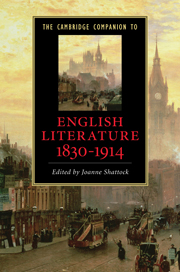Book contents
- Frontmatter
- Introduction
- Part 1 Modes of writing and their contexts
- 1 Authors and authorship
- 2 Readers and readerships
- 3 Life writing
- 4 The culture of criticism
- 5 Women’s voices and public debate
- 6 Writing the past
- 7 Radical writing
- 8 Popular culture
- Part II Intersections and incursions
- Part III The centre and the periphery
- Guide to further reading
- Index
2 - Readers and readerships
from Part 1 - Modes of writing and their contexts
Published online by Cambridge University Press: 28 November 2010
- Frontmatter
- Introduction
- Part 1 Modes of writing and their contexts
- 1 Authors and authorship
- 2 Readers and readerships
- 3 Life writing
- 4 The culture of criticism
- 5 Women’s voices and public debate
- 6 Writing the past
- 7 Radical writing
- 8 Popular culture
- Part II Intersections and incursions
- Part III The centre and the periphery
- Guide to further reading
- Index
Summary
The ‘reading revolution’
The period 1830-1914 saw some of the greatest changes in readerships and the types and availability of reading material ever experienced in the Western world. These changes had already begun by the late eighteenth century, but the majority of them only came to fruition during the Victorian era; it was only after progressive nineteenth-century legislation had finally over-ruled the preceding generation’s fears of a print-fuelled social revolution that real and lasting changes in reading patterns became possible.
The shift from eighteenth- to nineteenth-century reading habits has often been characterized as a shift from 'intensive' to 'extensive' reading: a change, that is, from the regular, repeated reading of a few expensive texts by a few privileged readers to the rapid consumption of a wider range of cheaper ones by a broader audience. It is certainly irrefutable that reading matter gradually became far cheaper and more plentiful between 1830 and 1914, and that there were more readers to enjoy it. The numbers of books and newspapers produced more than quadrupled across the century. The population of England, Scotland and Wales more than trebled from 10.5 million in 1801 to around 37 million by 1901. Literacy rates in England and Wales increased from about 60 per cent of men and 45 per cent of women in 1800, to 94 and 93 per cent respectively by 1891. This was due both to industrialization and to a concomitant demand for a more literate workforce, and to parliamentary reform which speeded up the increase with successive compulsory education acts after 1870. Overall, the effect was more readers at the end of the nineteenth century than at the beginning, and more printed matter to satisfy their demands.
- Type
- Chapter
- Information
- The Cambridge Companion to English Literature, 1830–1914 , pp. 30 - 49Publisher: Cambridge University PressPrint publication year: 2010

